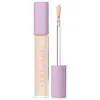What's inside
What's inside
 Key Ingredients
Key Ingredients

 Benefits
Benefits

 Concerns
Concerns

 Ingredients Side-by-side
Ingredients Side-by-side

Water
Skin ConditioningHydrogenated Polyisobutene
EmollientIsononyl Isononanoate
EmollientPropanediol
SolventGlycerin
HumectantPolyglyceryl-3 Polyricinoleate
EmulsifyingPolyglyceryl-3 Diisostearate
EmulsifyingDisteardimonium Hectorite
StabilisingSorbitan Isostearate
EmulsifyingMagnesium Sulfate
Sodium Dehydroacetate
PreservativeCaprylyl Glycol
Emollient1,2-Hexanediol
Skin ConditioningMagnesium Stearate
Cosmetic ColorantTocopheryl Acetate
AntioxidantSodium Lauroyl Glutamate
Lysine
Skin ConditioningMagnesium Chloride
Sodium Hyaluronate
HumectantCassia Angustifolia Seed Polysaccharide
Skin ConditioningCentella Asiatica Extract
CleansingLactobacillus Ferment Lysate
Skin ConditioningCamellia Sinensis Leaf Extract
AntimicrobialPunica Granatum Bark/Fruit Extract
AntimicrobialLactobacillus Ferment
Skin ConditioningCaffeine
Skin ConditioningCI 77002
Cosmetic ColorantCI 77891
Cosmetic ColorantIron Oxides
Water, Hydrogenated Polyisobutene, Isononyl Isononanoate, Propanediol, Glycerin, Polyglyceryl-3 Polyricinoleate, Polyglyceryl-3 Diisostearate, Disteardimonium Hectorite, Sorbitan Isostearate, Magnesium Sulfate, Sodium Dehydroacetate, Caprylyl Glycol, 1,2-Hexanediol, Magnesium Stearate, Tocopheryl Acetate, Sodium Lauroyl Glutamate, Lysine, Magnesium Chloride, Sodium Hyaluronate, Cassia Angustifolia Seed Polysaccharide, Centella Asiatica Extract, Lactobacillus Ferment Lysate, Camellia Sinensis Leaf Extract, Punica Granatum Bark/Fruit Extract, Lactobacillus Ferment, Caffeine, CI 77002, CI 77891, Iron Oxides
Water
Skin ConditioningIsododecane
EmollientDimethicone
EmollientAlcohol Denat.
AntimicrobialButylene Glycol
HumectantGlycerin
HumectantTrimethylsiloxysilicate
EmollientDiphenylsiloxy Phenyl Trimethicone
Skin ConditioningSynthetic Fluorphlogopite
PEG-10 Dimethicone
Skin ConditioningNiacinamide
SmoothingSodium Hyaluronate
HumectantSilica
AbrasiveDisteardimonium Hectorite
StabilisingIsopropyl Lauroyl Sarcosinate
Skin ConditioningDiisopropyl Sebacate
EmollientMagnesium Sulfate
Dimethicone/Vinyl Dimethicone Crosspolymer
Skin ConditioningBis-PEG/PPG-14/14 Dimethicone
EmollientDisodium Stearoyl Glutamate
CleansingPhenoxyethanol
PreservativePropylene Carbonate
SolventCaffeine
Skin ConditioningDipentaerythrityl Tetrahydroxystearate/Tetraisostearate
Skin ConditioningSilica Silylate
EmollientTocopherol
AntioxidantAluminum Hydroxide
EmollientTin Oxide
AbrasiveCI 77891
Cosmetic ColorantCI 77491
Cosmetic ColorantCI 77492
Cosmetic ColorantCI 77499
Cosmetic ColorantMica
Cosmetic ColorantCI 77163
Cosmetic ColorantWater, Isododecane, Dimethicone, Alcohol Denat., Butylene Glycol, Glycerin, Trimethylsiloxysilicate, Diphenylsiloxy Phenyl Trimethicone, Synthetic Fluorphlogopite, PEG-10 Dimethicone, Niacinamide, Sodium Hyaluronate, Silica, Disteardimonium Hectorite, Isopropyl Lauroyl Sarcosinate, Diisopropyl Sebacate, Magnesium Sulfate, Dimethicone/Vinyl Dimethicone Crosspolymer, Bis-PEG/PPG-14/14 Dimethicone, Disodium Stearoyl Glutamate, Phenoxyethanol, Propylene Carbonate, Caffeine, Dipentaerythrityl Tetrahydroxystearate/Tetraisostearate, Silica Silylate, Tocopherol, Aluminum Hydroxide, Tin Oxide, CI 77891, CI 77491, CI 77492, CI 77499, Mica, CI 77163
 Reviews
Reviews

Ingredients Explained
These ingredients are found in both products.
Ingredients higher up in an ingredient list are typically present in a larger amount.
Caffeine is most associated with coffee, tea, and cacao. In skincare, it helps with calming inflammation and is rich in antioxidants.
While caffeine is used to treat cellulite and and dark circles, further studies are needed to prove this. It has been believed to help with these skin conditions due to its ability to dilate blood vessels and increase blood flow.
Some studies are looking into caffeine's ability to protect against UV rays.
Learn more about CaffeineCi 77891 is a white pigment from Titanium dioxide. It is naturally found in minerals such as rutile and ilmenite.
It's main function is to add a white color to cosmetics. It can also be mixed with other colors to create different shades.
Ci 77891 is commonly found in sunscreens due to its ability to block UV rays.
Learn more about CI 77891Disteardimonium Hectorite comes from the clay mineral named hectorite. It is used to add thickness to a product.
It can also help stabilize a product by helping to disperse other ingredients.
Hectorite is a rare, white clay mineral.
Learn more about Disteardimonium HectoriteGlycerin is already naturally found in your skin. It helps moisturize and protect your skin.
A study from 2016 found glycerin to be more effective as a humectant than AHAs and hyaluronic acid.
As a humectant, it helps the skin stay hydrated by pulling moisture to your skin. The low molecular weight of glycerin allows it to pull moisture into the deeper layers of your skin.
Hydrated skin improves your skin barrier; Your skin barrier helps protect against irritants and bacteria.
Glycerin has also been found to have antimicrobial and antiviral properties. Due to these properties, glycerin is often used in wound and burn treatments.
In cosmetics, glycerin is usually derived from plants such as soybean or palm. However, it can also be sourced from animals, such as tallow or animal fat.
This ingredient is organic, colorless, odorless, and non-toxic.
Glycerin is the name for this ingredient in American English. British English uses Glycerol/Glycerine.
Learn more about GlycerinMagnesium Sulfate is a salt. More specifically, it is an epsom salt, or the bath salt used to help relieve muscle aches.
Despite having ‘sulfate’ in the name, it isn’t a surfactant or cleansing agent like sodium lauryl sulfate. Unlike those sulfates, magnesium sulfate doesn’t have the same cleansing or foaming properties (it's simply a type of salt).
In cosmetics, Magnesium Sulfate is used to thicken a product or help dilute other solids. It is a non-reactive and non-irritating ingredient.
One study shows magnesium deficiency may lead to inflammation of the skin. Applying magnesium topically may help reduce inflammation.
You can find this ingredient in sea water or mineral deposits.
Learn more about Magnesium SulfateSodium Hyaluronate is hyaluronic acid's salt form. It is commonly derived from the sodium salt of hyaluronic acid.
Like hyaluronic acid, it is great at holding water and acts as a humectant. This makes it a great skin hydrating ingredient.
Sodium Hyaluronate is naturally occurring in our bodies and is mostly found in eye fluid and joints.
These are some other common types of Hyaluronic Acid:
Learn more about Sodium HyaluronateWater. It's the most common cosmetic ingredient of all. You'll usually see it at the top of ingredient lists, meaning that it makes up the largest part of the product.
So why is it so popular? Water most often acts as a solvent - this means that it helps dissolve other ingredients into the formulation.
You'll also recognize water as that liquid we all need to stay alive. If you see this, drink a glass of water. Stay hydrated!
Learn more about Water